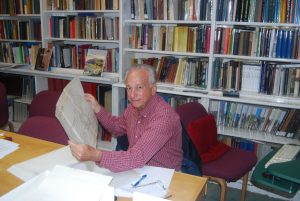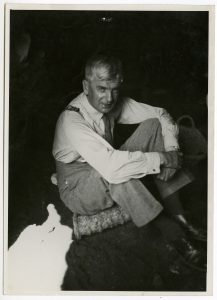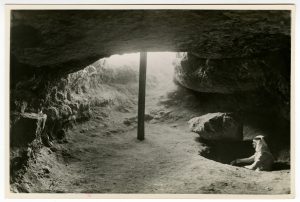
RESEARCH IN THE PALESTINE EXPLORATION FUND ARCHIVES
Samuel Wolff, 2017 Study of Collections Fellowship Recipient

Sam Wolff in the library of the PEF examining the plan from Rowe’s 1934 excavation (Photographer: John MacDermot.)
In September 2017, I visited the offices of the Palestine Exploration Fund in London in order to study the archival material from the 1934 excavation directed by Alan Rowe at the western side of Tel Gezer. The material, which was well organized and computerized, consisted of the registry of finds from the excavation, a copy of which I had already examined at the Israel Antiquities Authority archives in Jerusalem; all of the pre-excavation correspondence; all surviving photographs of the excavation; a plan and sections, the same ones that were published by Rowe in PEFQSt 68 (1935); the text of the reports that Rowe published in QDAP 4 (1935) and PEFQSt; and a list of the finds according to period as determined by Rowe, the same list that was supposed to be addended to the PEFQSt article (as stated on page 19) but was omitted.
As a result of this research I will be able to better document my report on this excavation with original photographs, plan and section that were graciously provided to me by the PEF. In addition, I was able to pick up tidbits that put the excavation into perspective:
1. Rowe held out for a higher salary. He requested ₤70 as a monthly salary, and the PEF was only willing to pay what he had previously received, ₤50! The PEF went so far as to ask that John Crowfoot, the Director of the British School in Jerusalem, conduct the excavation on his own salary, thus saving the PEF ₤70 per month, a request that Crowfoot rejected. In the end, Sir Charles Marston agreed to cover this expense and Rowe was hired.
2. The excavation was intended to last 4–5 weeks; no evidence for future additional seasons was found.
3. The Bentwich family, which sponsored the excavation (funds matched by Marston), requested that Rowe takes on Muriel Bentwich as a staff member for recording and drawing. The reply was positive, adding that it stands to reason that they shouldn’t have to pay her a stipend, given that the family was a wealthy one. In a letter signed by Norman Bentwich, it was stated that Muriel participated in several archaeological excavations, including with Rowe at Beisan (Beth Shan), Petrie at Gaza, FitzGerald at Beisan and Grant at Beth Shemesh; Samaria can be added to this list as well. I assume that it was Muriel who expertly recorded all the information, along with drawings to scale, that appears in the registry of finds.
4. Previously unknown to me is the fact that a house, owned by a certain Mr. Goldwaters, existed on the mound, c. 39 m. to the south of the excavations. This house, which appears in a photograph, was put at the team’s disposal for the duration of the excavations. Another photograph shows two houses in its background. It could be that the foundations of these houses were later incorporated into the Hebrew Union College excavation camp.
Documents in the IAA Archives listed the finds from Rowe’s excavation that were to remain in the Palestine Archaeological Museum (now called the Rockefeller Museum). I was hopeful that correspondence in the PEF archives would help me track down the remaining objects from this excavation. Unfortunately, this was not to be the case, except for one note that implied that the intention was for the objects to be sent back to England. I was informed, however, that a handful of ceramic vessels were at the Institute of Archaeology, UCL. This proved to be the case, but these objects were not accessible during the time of my visit; they will be drawn and photographed on my behalf as soon as it becomes possible to do so. In addition, I was able to examine one object, an impressively preserved 32.5 cm long bronze dagger, at the PEF.
I wish to express my gratitude to Felicity Cobbing, Executive Secretary of the PEF, and John MacDermot, Hon. Secretary, for their hospitality, and to ASOR for providing me with a Special Collection Fellowship which enabled me to travel to the PEF.

